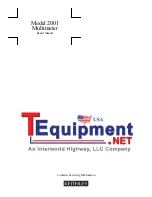
Common Mode Errors
Errors are generated when the multimeter’s input LO terminal is driven
with an ac voltage relative to earth. The most common situation where
unnecessary common mode voltages are created is when the output of
an ac calibrator is connected to the multimeter “backwards.” Ideally,
a multimeter reads the same regardless of how the source is connected.
Both source and multimeter effects can degrade this ideal situation.
Because of the capacitance between the input LO terminal and earth
(approximately 200 pF for the HP 34401A), the source will experience
different loading depending on how the input is applied. The magnitude
of the error is dependent upon the source’s response to this loading.
The multimeter’s measurement circuitry, while extensively shielded,
responds differently in the backward input case due to slight differences
in stray capacitance to earth. The multimeter’s errors are greatest for
high- voltage, high-frequency inputs. Typically, the multimeter will
exhibit about 0.06% additional error for a 100 V, 100 kHz reverse input.
You can use the grounding techniques described for dc common mode
problems to minimize ac common mode voltages (
see page 201
).
AC Current Measurement Errors
Burden voltage errors, which apply to dc current, also apply to ac
current measurements. However, the burden voltage for ac current is
larger due to the multimeter’s series inductance and your measurement
connections. The burden voltage increases as the input frequency
increases. Some circuits may oscillate when performing current
measurements due to the multimeter’s series inductance and your
measurement connections.
Chapter 7 Measurement Tutorial
Common Mode Errors
212
Summary of Contents for 34401A
Page 12: ...1 Quick Start 1 ...
Page 26: ...2 Front Panel Menu Operation 2 ...
Page 50: ...3 Features and Functions 3 ...
Page 103: ...4 Remote Interface Reference 4 ...
Page 135: ...SCPI Status System 4 Chapter 4 Remote Interface Reference The SCPI Status Model 135 ...
Page 170: ...5 Error Messages 5 ...
Page 182: ...6 Application Programs 6 ...
Page 196: ...7 Measurement Tutorial 7 ...
Page 214: ...8 Specifications 8 ...
















































